According to the National Fire Protection Association, Standard 13 for the Installation of Sprinkler Systems, §3.3.61.1.1, a drop-out ceiling is “a suspended ceiling system, which is installed below the [fire suppression] sprinklers, with listed translucent or opaque panels that are heat sensitive and fall from their setting when exposed to heat.” A drop ceiling allows fire suppression sprinklers to be located above a suspended grid ceiling, out of sight but still fully functional.
Fire and life-safety is a concern for anyone owning or operating a building. Certain types of occupancies require fire suppression sprinklers, which are usually quite visible. In places with suspended grid ceilings, sprinklers are often seen poking through holes in the centers of ceiling panels. The installation of these penetrating sprinklers, especially in coordination with ceiling installation, is an expensive and time-consuming process. The pass-through heads add to the visual clutter of the ceiling and complicate cleaning and above-ceiling maintenance work.
Drop-out ceilings provide an alternative to pass-through sprinkler installations and avoid the need to install drops from sprinkler mains so that sprinklers can penetrate the ceiling and discharge water into the room below. This enables drop-out ceilings to be used in situations where pass-through sprinklers are not the optimum solution.
When do Drop-out Ceilings Make Sense?
There are numerous situations where penetrating sprinklers are not the optimum solution, and a drop-out ceiling may be a better choice. Drop-out ceilings should be considered when any of these considerations are applicable:
Cost and constructability
Drop-out ceiling products are cost competitive with comparable products that lack drop-out characteristics. Their economy is the result of keeping sprinklers above ceilings to reduce the cost of sprinkler installation. For example, dropout ceilings eliminate the need to extend (drop) pipes from sprinkler mains (usually located just under a floor or roof structure) down to ceiling height. Installation is also simplified by not having to position sprinklers at the centers of panels. Non-appearance grade sprinklers can be used and finishing rings and escutcheons can be eliminated. Time required to cut holes for penetrations in ceiling panels is also eliminated.
In addition to these direct cost savings, dropout ceilings can reduce job-site overhead costs and save time on the job.
For example, installing penetrating sprinklers requires multiple steps that must be performed in a certain sequence:
- Install sprinkler mains.
- Install ceiling grid.
- Install sprinkler drops in center of grid spaces.
- Install ceiling panels.
- Install sprinkler heads and trim.
This creates a back-and-forth between the plumber and ceiling tile installer – the kind of coordination that often causes costly delays.
Installing drop-out ceilings, on the other hand, requires just two steps:
- Install sprinkler system.
- Install ceiling beneath sprinklers.
Simplifying coordination of sprinklers and ceilings can shorten the critical path to complete a project.
Drop-out ceilings also make good economic sense during renovation projects by allowing a ceiling to be installed without having to modify existing sprinklers. One such case was a commercial bakery that took over an unused bay in a mattress factory. Needing to add a suspended grid ceiling for hygienic reasons, they used drop-out panels. The bakery’s general manager, who spearheaded the renovation, said that the savings from not needing to add sprinkler drops paid for the ceiling itself.
Aesthetics
Some penetrating sprinklers are fully exposed beneath a ceiling. Where this is not visually acceptable, semi-exposed (recessed) sprinkler heads, or concealed heads can be used. Concealed sprinklers have a cover plate that will drop-out when exposed to heat from a fire. The wide-spread acceptance of drop-out sprinkler covers should inspire confidence in the viability of drop-out ceilings that function according to similar principles.
While concealed sprinkler covers are nearly flush to the bottom of the ceiling surface and can have a color similar to the ceiling, they are not truly concealed; they can be seen from below when viewed at typical ceiling heights and lighting. The cover and ceiling texture can vary, and covers can be especially visible if care is not taken to center sprinklers in panels and install them at uniform intervals. The covers add to the visual clutter of air diffusers, light fixtures, sensors, public address speakers, and other services that detract from the appearance of a ceiling.
Keeping sprinklers completely above drop-out ceilings eliminates sprinklers as an aesthetic concern.
Luminous Ceilings
NFPA's definition of drop-out ceilings incudes the possibility of using translucent materials. This is not coincidental, as the history of drop-out ceilings began with the search for better luminous ceilings. These ceilings were a signature of many mid-century modern buildings, made possible by the growing affordability at the time of fluorescent lamps and lightweight translucent thermoplastics. Architects objected to the shadows penetrating sprinklers cast on pristine light-emitting ceilings; in response, engineers determined how thermoplastic panels could be installed beneath sprinklers, and the drop-out ceiling was invented.
There has been a resurgence of interest in luminous ceilings, sparked in part by the proliferation of LED lighting solutions. Inexpensive, generic LED fixtures above ceiling panels can provide general illumination, spot lights, or a soft glow, and can be used above the entire ceiling or just over selected panels. Sprinklers remain out of sight above the LED strips and do not cast shadows onto the ceiling.
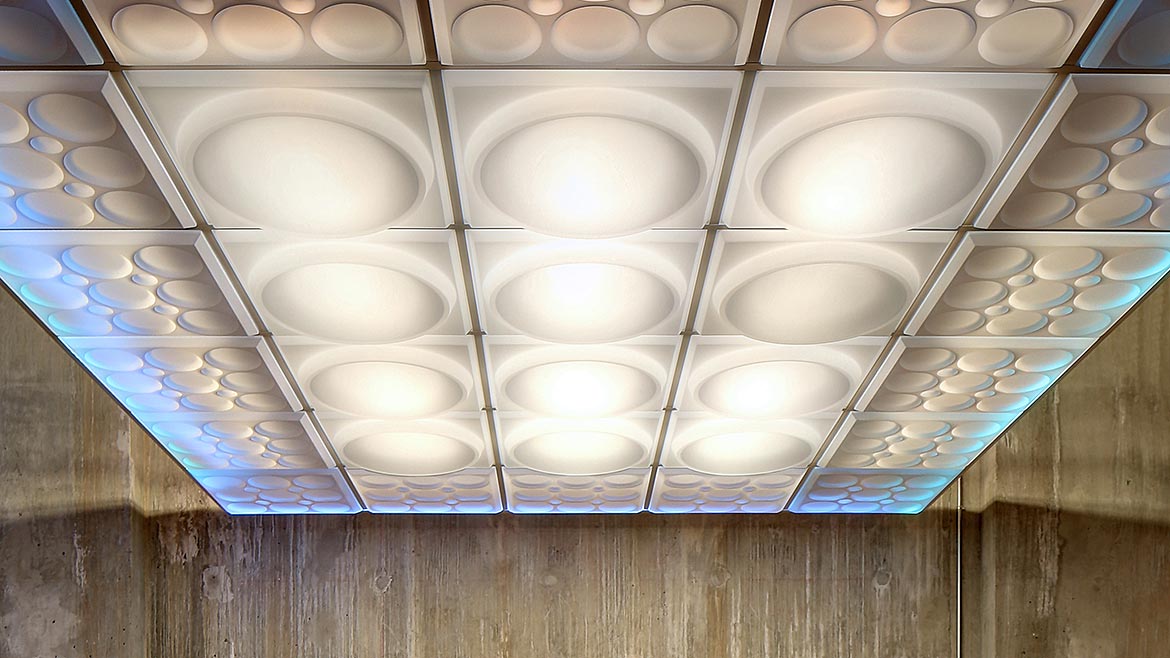
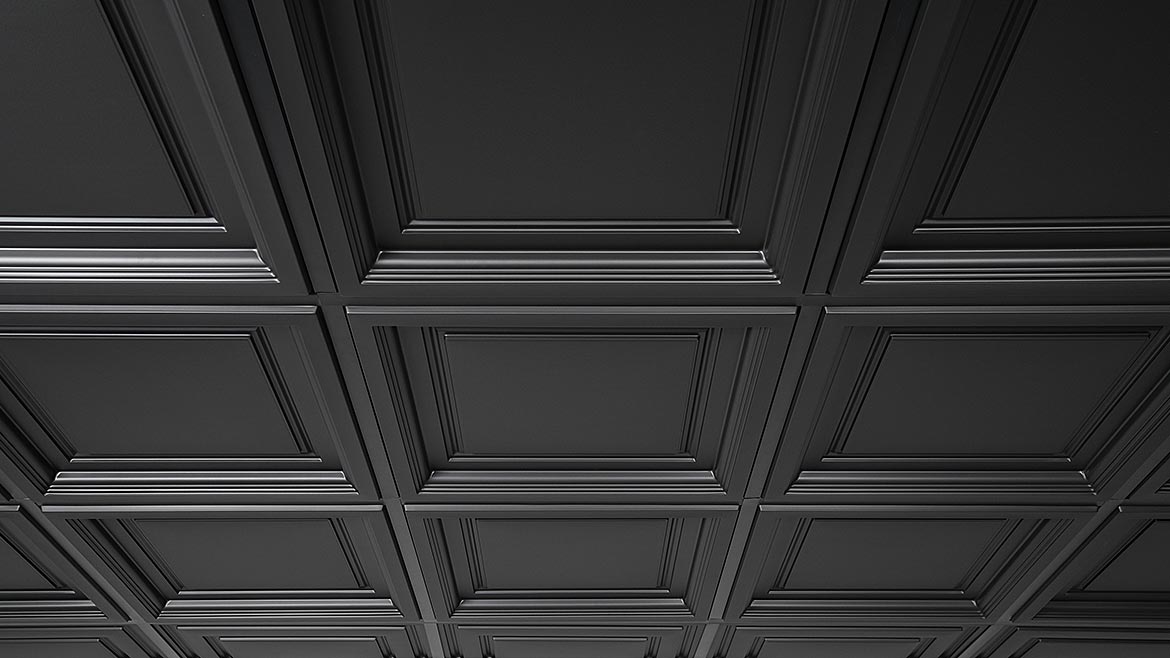
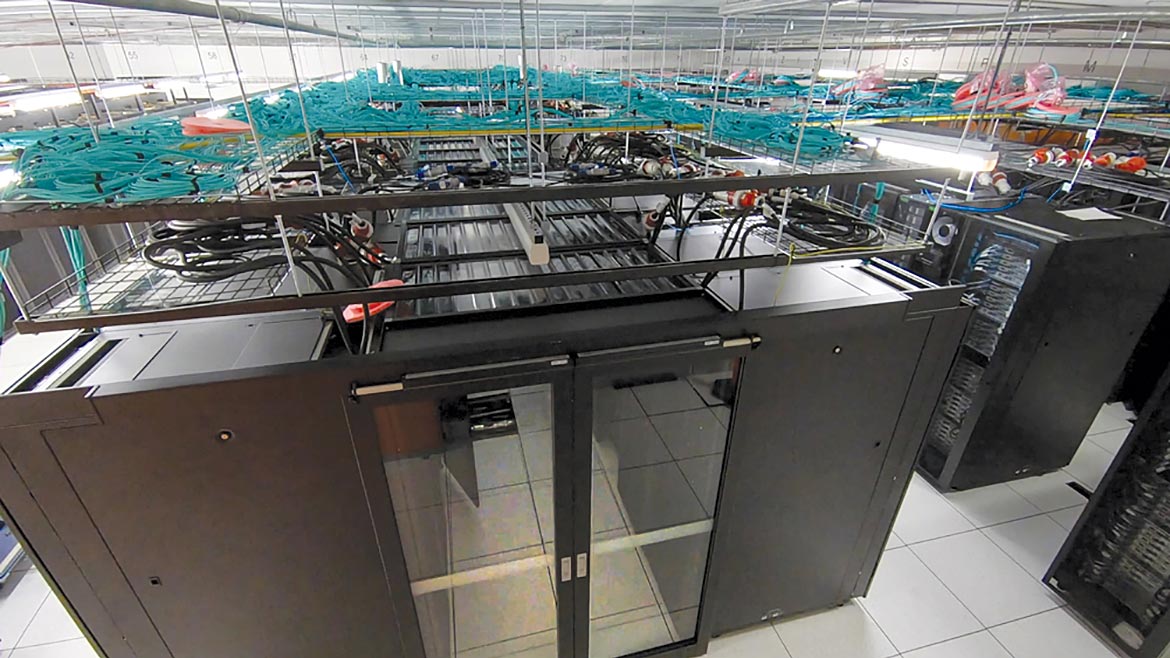
Room-Within-Room
There are many occasions when a 'roof' must be put over a space that is within a sprinkler fitted building. Examples include:
- A big-box store or shopping center that uses a store-within-store concept to create a boutique with a lowered ceiling and a more intimate ambience.
- An office or lab on a factory floor that needs to be enclosed to control dust, temperature, or other environmental factors.
- A meeting room within an open office that needs a covering for increased privacy, better illumination, or to create a better sense of place.
- A canopy over a display within a convention center, gallery, or museum.
A drop-out ceiling avoids the need to install separate sprinklers within the enclosed space. Light-transmitting panels also permit the use of borrowed light from overhead luminaires.
Soffits and Ceiling Clouds
Like a room-within-room scenario, drop-out ceilings can eliminate the need to install sprinklers both above and below the ceiling, and can also be used for creative lighting.
Data Farms
One interesting variant of the room-within-room concept occurs in computer server facilities where racks of servers are kept cool and functional using energy-saving cold-aisle or hot-aisle ventilation systems. Cold air is pumped into the aisle of servers from the floor and is kept contained by a ceiling close over the racks, making the aisle function as an air duct.
Clear drop-out ceilings are used in this application allowing fire sprinkler protection for the servers, as well as admitting light from above so that additional illumination is not needed in the aisles.
Environmental Separation
Dust, grease, and other contaminants can collect on penetrating sprinklers; cleaning requires care to prevent damaging sprinklers. More, the holes cut for penetrating sprinklers create openings that permit the passage of air, insects, dust, and other matter that can compromise the energy efficiency, hygiene, and cleanliness of the covered space. While the gap around each sprinkler penetration is small, their aggregate effect can be detrimental. This is especially important for ceilings with strict requirements for cleanliness, such as those in food preparation areas and healthcare facilities.
Another form of environmental separation has to do with heat stratification. Hot air rises, making it difficult to warm occupants at floor level, especially in spaces with high structural ceilings. Installing a suspended ceiling reduces the volume of air requiring heating, thus saving energy, and reducing costs.
Differential Movement
The pipes in a sprinkler system are more rigid than a ceiling's suspension wires and lightweight grid. Differential displacement due to seismic, settlement, or other movement can damage sprinklers, ceiling panels, or both.
The potential for damage can be ameliorated by using flexible drops that may add to the cost of construction. Another approach is to oversize the holes through which sprinklers penetrate to allow for anticipated movement; this practice, however, reduces the ceiling's effectiveness as an environmental separation as discussed in the preceding section.
Alternatively, the potential for damage can be eliminated altogether by decoupling the sprinklers from the ceiling and using a drop-out ceiling.
Maintenance
One of the advantages of a suspended grid ceiling is that panels may be easily removed (and reinstalled) to allow access to the interstitial space above the ceiling. This allows maintenance, cleaning, repair, or replacement of the mechanical and other services above the ceiling. Penetrating sprinklers complicate this work and requires extra care to extricate panels from sprinklers without damaging either. Drop-out ceilings offer on-going advantages for building maintenance.
Abuse or Accidents
Penetrating sprinklers can be damaged by accidental impact, careless maintenance, or by malicious tampering. Locating sprinklers above drop-out ceilings may not eliminate incidents but will keep sprinklers out of the way of damage and out of sight of potential vandals.
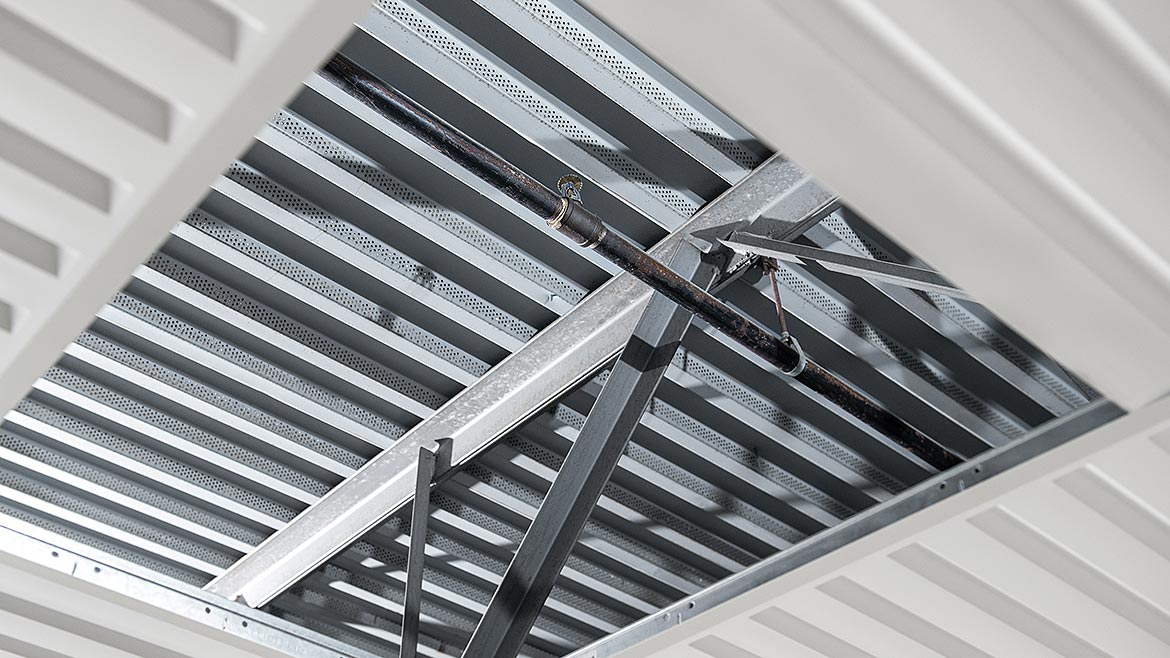
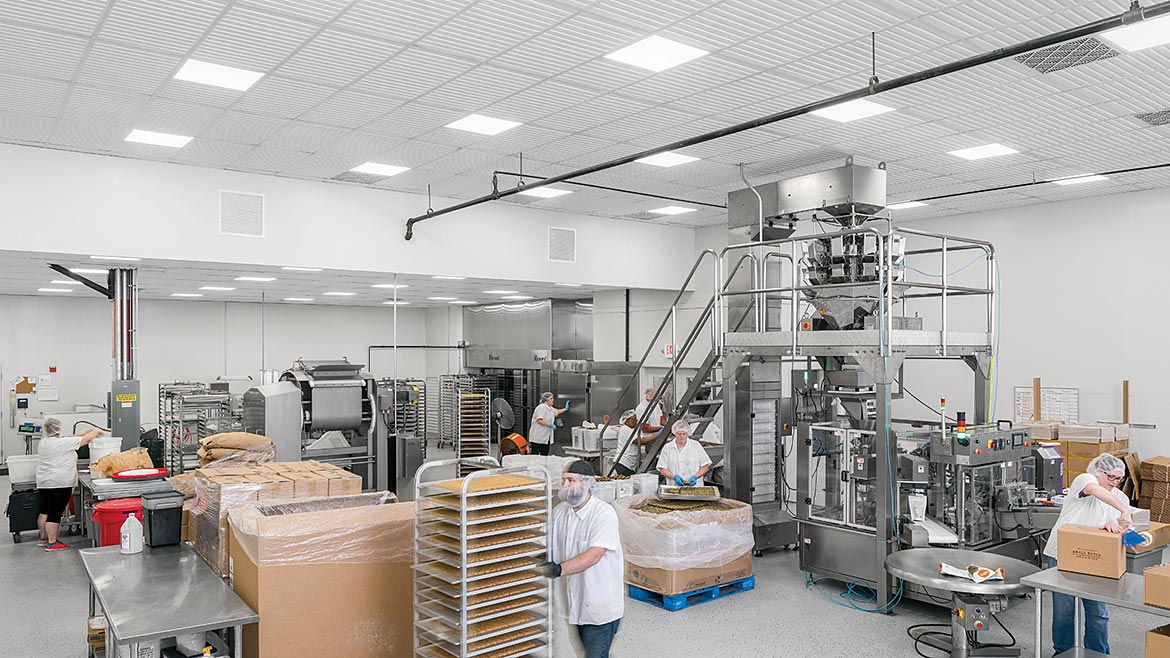
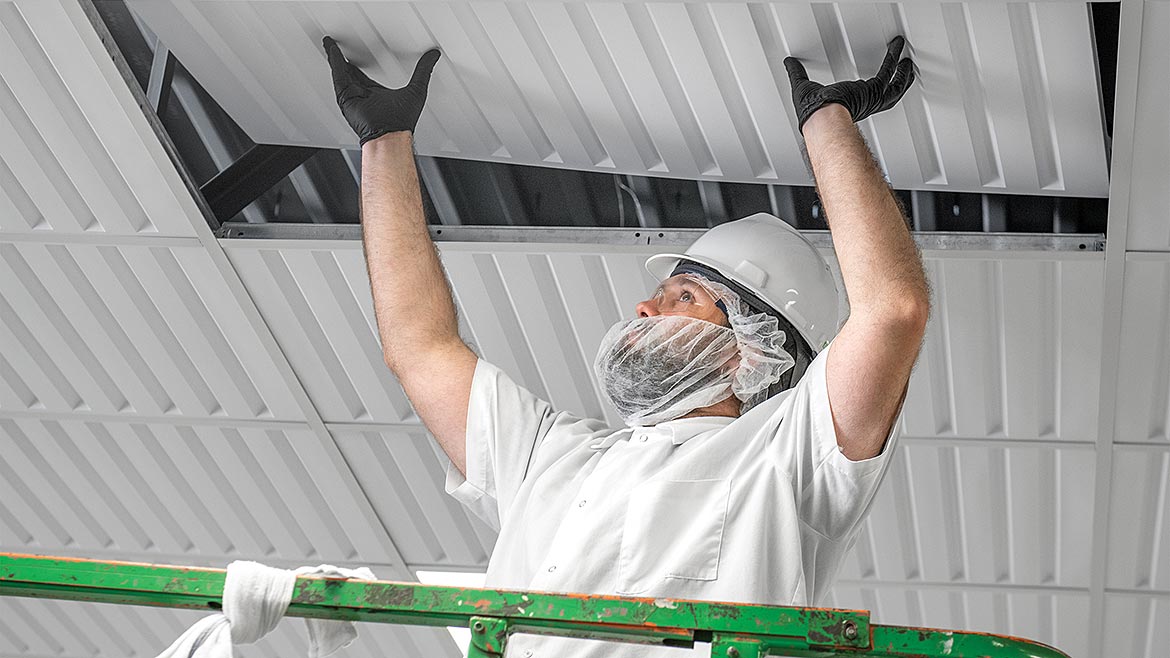
What Types of Drop-out Ceilings Are Available?
Thermoformed panels
The original type of drop-out ceiling remains the system with the longest history of performance and for which the most technical data is available. Panel designs from one of the original manufacturers are still made, molded from rigid vinyl that is either 0.33 or 0.76 mm (0.013 or 0.03 in.) thick. When heat from a fire raises the air temperature at the ceiling to approximately 120 degrees Fahrenheit—hotter than temperatures in commonly occupied spaces and less than the temperature required to discharge the sprinklers—the lightweight thermoplastic softens and sags, then falls intact and harmlessly to the floor. The heat then rises to the height of the sprinklers and causes them to discharge.
Rigid vinyl has good fire resistance characteristics, and the panels are rated Class-A when tested according to ASTM E84 Surface Burning Characteristics of Building Materials and Flame Class V-0 per UL 94 Standard for Safety of Flammability of Plastic Materials for Parts in Devices and Appliances. They are the subject of an evaluation report from the International Association of Plumbing and Mechanical Officials Uniform Evaluation Service (IAPMO-UES) for compliance with International Building Code requirements, and have additional listings and approvals from UL, FM, and the California Fire Marshal.
The listings and approvals specify the panels can be used with either standard response or quick response sprinklers that operate at 135 degrees Fahrenheit or above and with either dry or wet pipe systems. Sprinklers must be installed no less than 25.4 mm (1 inch) and no more than 1.5 meters (5 feet) above the drop-out ceiling panels. They are acceptable in light hazard and Group 1 ordinary hazard occupancies as defined in NFPA 13 and in Seismic Design Categories B, C, D, E, or F. They can be used with or without uplift-prevention clips, and with suspension grid tees that are either 24 mm (0.94 in. [nominal one inch]) or 14 mm (0.56 in. [slim line]) wide.
EPS Panels
Drop-out ceiling panels made from EPS foam are typically called “melt-out ceilings.” The EPS Industry Alliance states, “When installed correctly, expanded polystyrene products do not present an undue fire hazard.” It also recommends, however, “… that expanded polystyrene should be protected by a thermal barrier in specific applications as referenced in [applicable codes].” This may limit the occupancies in which EPS ceiling panels can be used.
Some EPS panels are listed by insurance companies based on testing in accordance with UL 723S Drop-Out Ceilings Installed Beneath Automatic Sprinklers. They have either a flat or molded white surface. The 16 kg/m3 (1 pcf-) density foam from which they are made has limited strength or durability. They do not offer noise reduction value and can be used only with standard response sprinklers.
Stretched Ceilings
These ceilings use fabric that is stretched to provide a taut, flat ceiling surface that is held in place with perimeter gripping devices. The fabric panels are assembled with heat-sensitive stitches or seams. When exposed to heat, the seams become undone and tension in the stretched ceiling pulls the seams apart to expose sprinklers.
Some manufacturers use panels of translucent polypropylene fabric to make suspended covers that protect interior spaces from dust and contamination generated by reroofing or other overhead work. The fabric can also be used to form temporary partitions to create isolation areas for operations needing segregation from the rest of a space. These products are tested according to UL 723S and have an IAPMO-UES evaluation report recognizing its use as a dropout ceiling. The report limits the product to temporary use of up to 180 days. Each installation is engineered and installed by the product's manufacturer.
Several companies offer fabric systems used primarily in theatrical and exhibition installations. They use woven, synthetic textiles with fusible seams 305 mm (12 in.) on center. When the fabric reaches 71°C (160°F), the stretched knit contracts into small, bunched lines of material. This opens more than 70 percent of the ceiling area allowing heat to reach the sprinklers. Products in this category claim flame resistance, but consult authorities having jurisdiction for applicability to ceiling use.
While stretched fabric ceilings can be pulled back for access above the ceiling, they do not provide access as easily as panels in a ceiling grid. On the other hand, the stretch-ability of the fabrics allows for a modicum of curved surface and interesting architectural effects. Some of the fabric products can be easily printed upon to create stunning graphics.
Electro-mechanical Operations
There are also ceiling panels that dropout when an electro-mechanical latch releases in response to an electronic signal. While more expensive than the other options, they are useful where the ceiling must drop-out due to smoke detection or other trigger besides temperature rise.
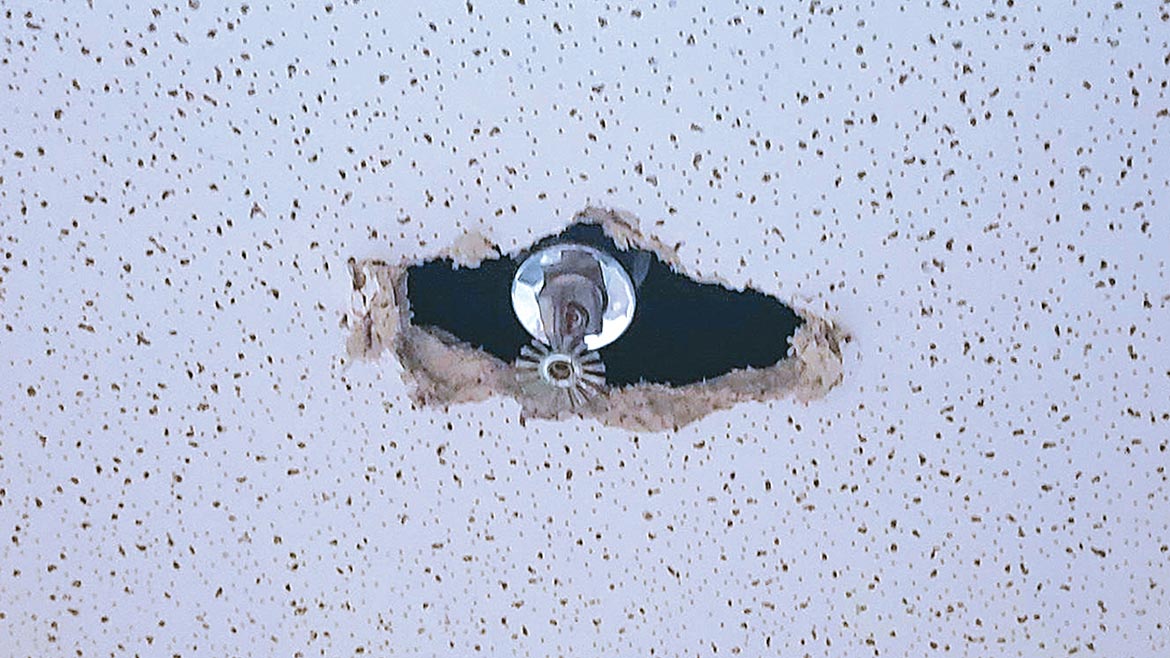
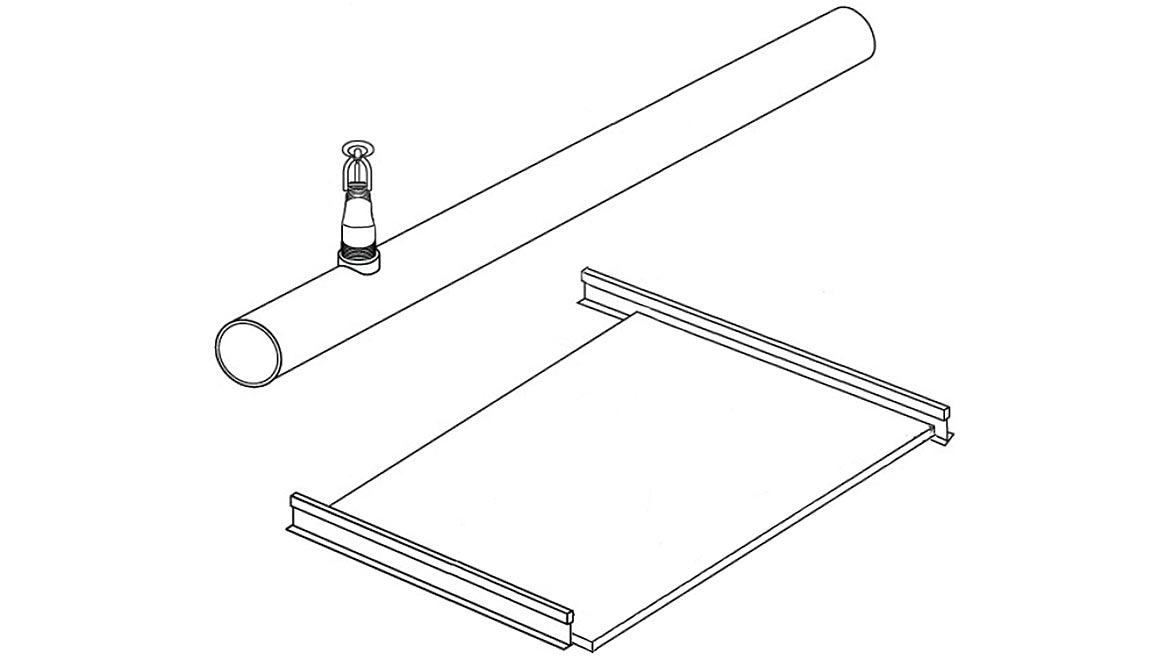
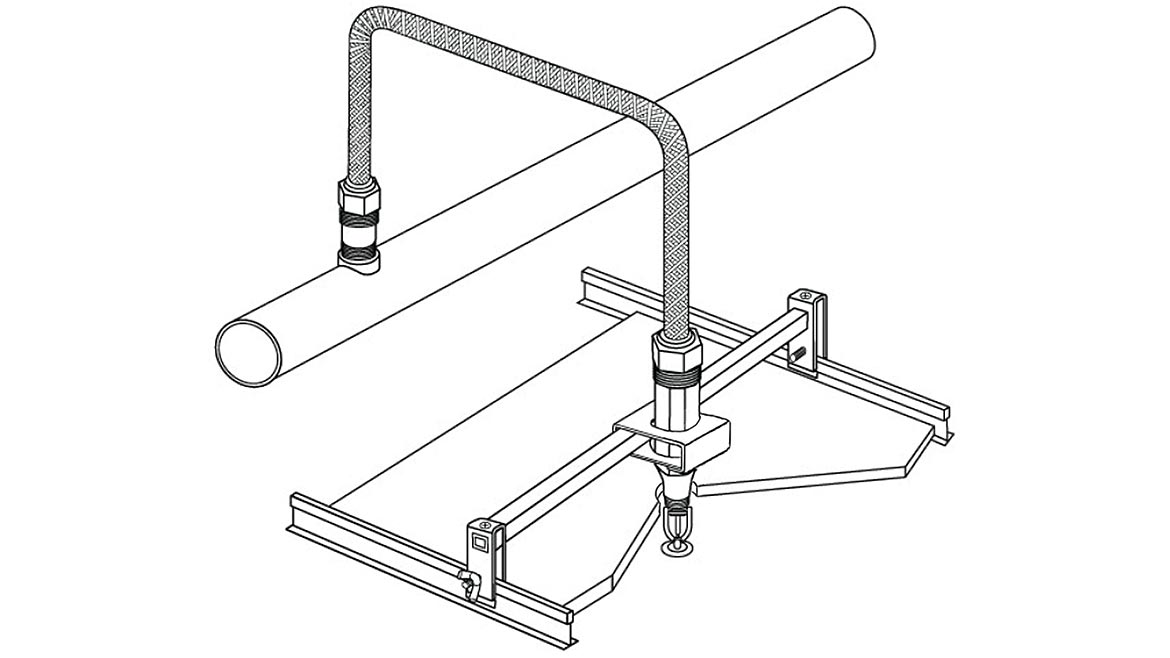
Conclusion
Drop-out ceilings have several significant advantages compared to conventional ceiling systems:
- They can be a cost-effective solution, eliminating the need to drop sprinklers, making sprinkler positioning simple, and allowing the use of less costly, non-appearance grade sprinklers.
- They hide sprinklers and offer a visually uncluttered appearance.
- They open up the possibility of using translucent materials for illumination.
- They allow for room-within-room design concepts and environmental separation requirements.
- They offer significant advantages for building maintenance and provide protection for sprinklers—making them less prone to accidental knocks and tampering.
Too often, the project team defaults to penetrating sprinklers without considering other options. Building owners and others may find the benefits of drop-out ceilings justify their consideration.





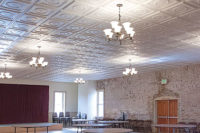
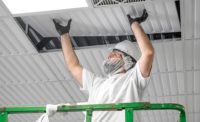
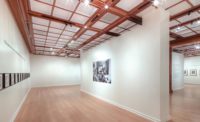
Report Abusive Comment